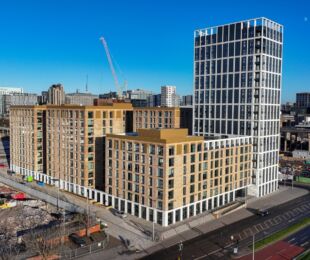
Born in Amsterdam in 1884, Michel de Klerk was apprenticed to architect Eduard Cuypers (1859-1927) at the age of 14, where he came to work with Piet Kramer and Johan van der Mey, later key exponents of the Amsterdam School. De Klerk set up his own office in 1911, and went on to design a series of ground-breaking apartment buildings for the Eigen Haard and De Dageraad housing associations.
Eigen Haard (Our Hearth) was set up following the 1901 Housing Act, introduced to improve housing conditions in Holland through the creation of cooperatives. It developed workers’ housing in the Spaarndammerbuurt district, west of the city centre, including De Klerk’s Het Schip (The Ship), which established him as the best known of the Amsterdam School architects.
De Klerk’s first commission, however, after working for 20 years in Cuyper's office, was for a private apartment building facing a park, the Spaarndammerplantsoen. It was built in 1913-15, in brick, five stories tall with a full facade on the top floor rather than the traditional mansard roof, and a distinct emphasis upon variations of materials and details. The other two buildings near the park were built for Eigen Haard. The second, opposite the first, featured eccentric windows, turrets, stairs and entrances, was completed in 1916.
The third project, Het Schip, built from 1917-20, forms a triangular perimeter building around a garden court. Shared entrances face the street while balconies face the garden. The block steps down from five to three floors at the east end where it faces the park, and where a small post office is located, whose entrance is marked by a squat tower (the post office was converted in 1999 into a museum for the design and architecture of the Amsterdam School). Faceted strip windows and brick bands lend a horizontal emphasis, while attic cranes, windows and doorways are eccentrically angled and detailed. At the west end the building is set back to form a public space, marked by a pointed tower. On the northerly Oostzaanstraat, a school occupies the lower two floors.
There are 102 apartments of 18 different types at Het Schip, mostly minimal dwellings with one or two bedrooms, and many with feature balconies facing both inwards or outwards. The enveloping facade steps forward and back, making various textural uses of the ubiquitous red brick, with a darker, hard brick employed at lower levels, and a softer, orange brick above. There is a consistent horizontal movement in the building’s surface, with bands of brick and tile, as well as long balconies tracing lines across the building. Windows, doors, and sculptural motifs appear in a variety of forms, reinforcing the nautical references of the whole complex. The decorative details in stone and brick that embellish the building’s façade are by sculptor Hildo Krop (1884-1970).
Het Schip is currently undergoing a major refurbishment by the non-profit-making Eigen Hard, aided by a 2015 Keeping It Modern grant from the Getty Foundation, which includes the development of a long-term maintenance plan, visual documentation and dissemination, and a guide for tenants. Contractor Vastbouw has been commissioned for the renovation, including a thorough updating of the apartments as well as energy efficiency improvements.






